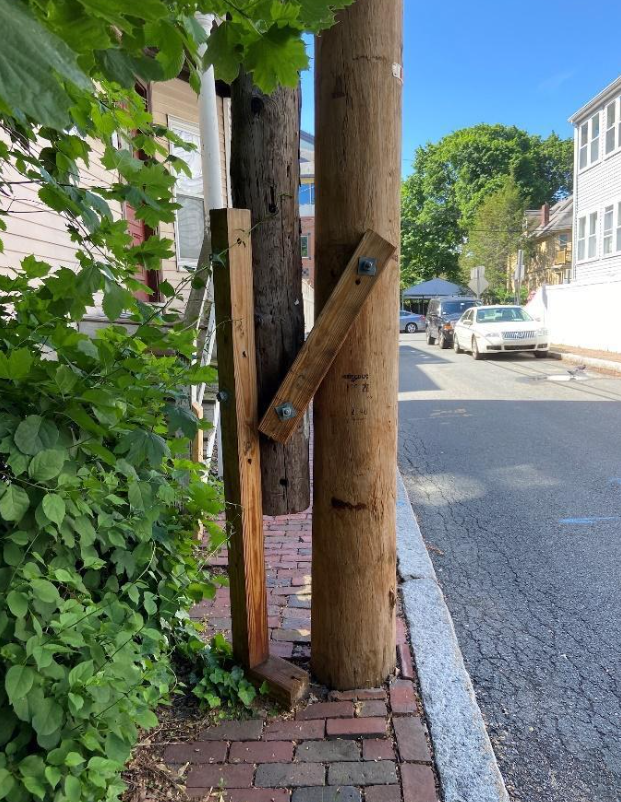Sistered beams and other sisterings: a partial ongoing glossary
Contributors
Transient Solidarity
- Sistered beams
A term used in construction, and specifically in the repair and adaptation of existing structures, ‘sistering’ refers to the addition of extra material to reinforce an existing, damaged structural member.1 The added material is referred to as the ‘sister’ of the original member, as in “sister stud” or “sister beam”. Sistering involves two or more ‘sistered’ parts being in intimate relation, and is contingent upon their interdependence—they are stronger with one another.
Sistering is structural interdependence with what already exists—it opens up sites for new relationships in place, without wholesale replacing or starting anew.
- Sistered telephone poles

- The Three Sisters
In much of Turtle Island, planting the Three Sisters—corn, beans, and squash—together is a common indigenous agricultural practice. Their relationships with each other are a perfect case of mutual support and interdependence: corn becomes the scaffold that the beans use to grow and climb vertically; beans become the subterranean negotiators as nitrogen fixers and nutrient converters within the soil, and squash becomes the sprawling guard as their leaves’ shade retains soil moisture and prevents weed growth.
Sistering is close partnership wherein individuals’ unique traits build off of each other to create something greater for an entire ecological community—it imagines abundance through deep collaboration.
- “I Am Your Sister”
Audre Lorde wrote an action-oriented pamphlet entitled I Am Your Sister: Black Women Organizing Across Sexualities2 , directed at non-lesbian Black women to address heterosexism and homophobia, to collectively build towards mutual survival. Her directives resonate for relationship-building: “we have many different faces, and we do not have to become each other in order to work together.”3 The mutual stretching across differences (of identity, of opinion) implies that all parties commit to internal and interpersonal work.
Sistering acts on core connections between individuals in spite of differences, and recognizes those very differences as a key source of strength—it posits the gaps between us as wellsprings of future power.
- To sister
Toni Cade Bambara wrote “… Sisters of the yam Sisters of the rice Sisters of the corn Sisters of the plantain… And we’re all on the line. Now that we’ve begun to break the silence and begun to break through the diabolically erected barriers and can hear each other and see each other, we can sit down with trust and break bread together. Rise up and break our chains as well.”4
As Bambara taught, “sister is a verb.”5
- Sister cities
“Sister cities” are cities that are geographically distinct, yet form an intentional social and commercial partnership. Sister cities hold the potential to be more if they began to share other responsibilities that cities carry, like education, housing, healthcare, infrastructure.
Sistering creates place-to-place bonds of mutual aid—it holds the possibility of transcending borders and political boundaries.
- Excerpt from “Notes on Sistering” by Lily Song6
“Sistering is an anti-supremacist, reparative design epistemology and methodology… Sistering proceeds by inviting, showing up, sharing and listening out. It is a series of call and response, pushing each other further and further with mutual challenges and affirmations…”
Sistering is a process and method of relationship-building and ongoing solidarity work, complete with the generative tensions and conflicts that come with creative interdependence.
Outro
Sistering is characterized by difference (in age, in material make-up, or otherwise) yet also by relational continuity, constant give and take, and shared loads to collectively hold up a whole. Might these and other cases of sistering be a blueprint for solidarities and intentional interdependencies moving forward? These instances begin to open portals into possible futures.
Sistering is far from new. Worlds are being built from seeds, possibilities, experiments in sistering. This incomplete and ongoing glossary holds fragments of sisterings we’re continuing to gather along our journey as designers, and we share it here as an invitation to recognize and lift up sistering in architecture.
- Wiktionary contributors, “sister,” Wiktionary, The Free Dictionary, https://en.wiktionary.org/w/index.php?title=sister&oldid=66452912 (accessed May 2, 2022). ↩︎
- Lorde, Audre. “I Am Your Sister: Black Women Organizing Across Sexualities”. Latham, NY: Kitchen Table: Women of Color Press, 1985. part of the Freedom Organizing Series. ↩︎
- ibid, p. 5, 3 ↩︎
- Moraga, Cherrie, Gloria Anzaldua, eds and Toni Cade Bambara. “Foreword.” Essay. In This Bridge Called My Back: Writings by Radical Women of Color, 2nd ed., xxix. Latham, NY: Kitchen Table/Women of Color Press, 1983. ↩︎
- Bambara, Toni Cade. quote “Sister is a Verb” (https://brokenbeautiful.wordpress.com/2013/09/20/sister-is-a-verb-clarifications-from-the-sistorians/). “Or as Toni Cade Bambara teaches us, via Aishah Shahidah Simmons “sister is a verb.”” (https://www.alexispauline.com/now/2020/4/6/the-red-line) ↩︎
- Song, Lily. “Notes on Sistering”. Essay. In CoDesign Field Lab: Black Belt Study for the Green New Deal. Harvard Graduate School of Design and the Destination Design School of Agricultural Estates. Accessed May 2, 2022. ↩︎